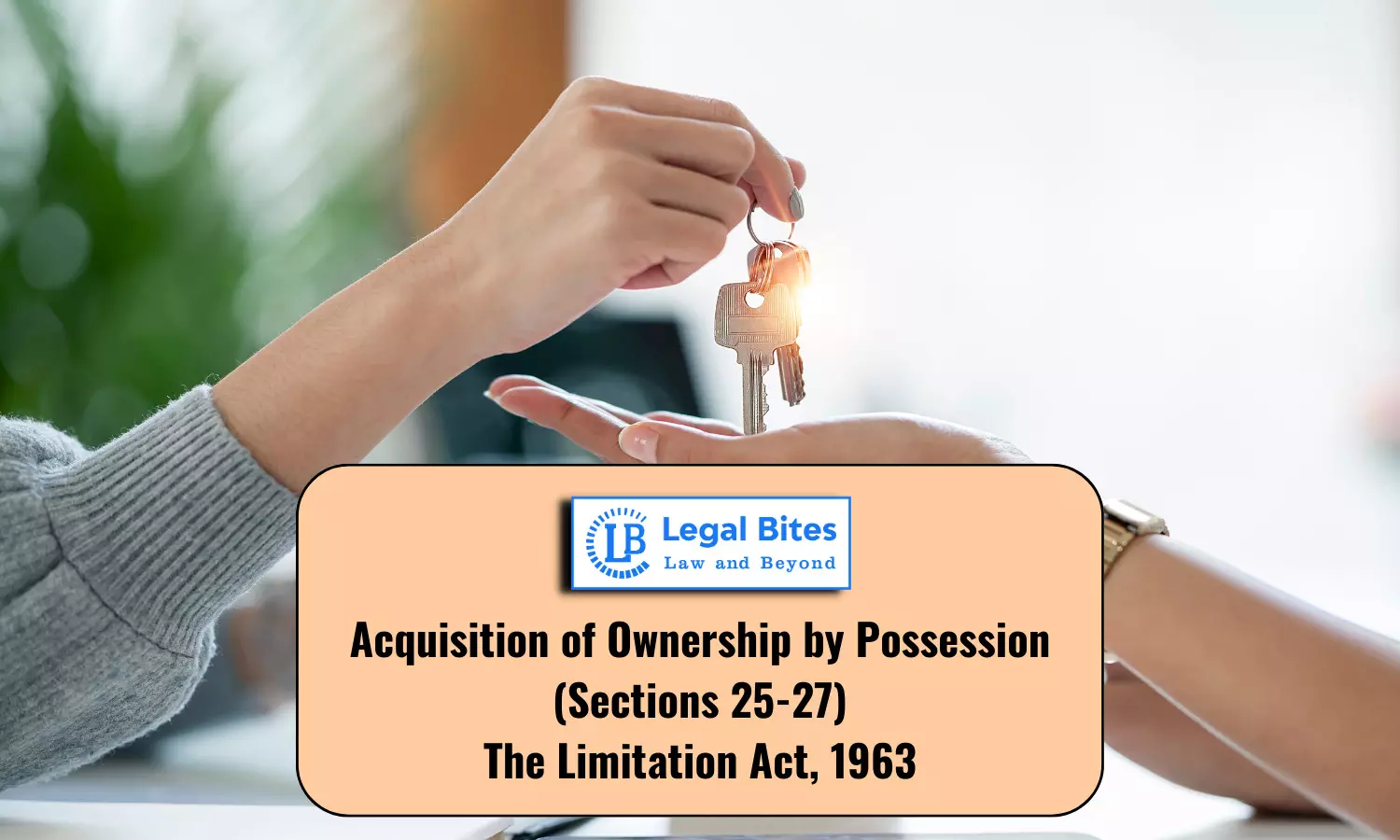Acquisition of Ownership by Possession (Sections 25-27) | The Limitation Act, 1963
A thorough comprehension of Sections 25-27 of the Limitation Act, 1963 offers readers intricate dynamics of time, possession and ownership acquisition

A thorough comprehension of Sections 25-27 of the Limitation Act, 1963 offers readers intricate dynamics of time, possession, and ownership acquisition
Introduction
In property law, there is a concept of acquisition of ownership rights based on possession and the passage of time. The Limitation Act, 1963 (hereinafter as “1963 Act”), which focuses on setting time limits on the initiation of legal proceedings and other legal actions, also touches upon this aspect of property law under Sections 25, 26 and 27. These provisions provide for situations where certain rights are acquired only through continuous possession of a property for stipulated periods.
While Section 25 deals with the acquisition of easements by prescription, thereby meaning it relates only to easementary rights and not natural rights, Section 26 stipulates the exclusion of time in favour of the reversioner of a servient tenement and must be read in light of Section 25. Further, Section 27 provides for the extinguishment of the property right. It is to be noted that under Section 29(4), it is provided that Sections 25 and 26 are not to be applied in cases which arise in territories where the Indian Easements Act, 1882 extends.
These provisions serve an important purpose by putting reasonable time limits on claims over property and also mitigating indefinite legal battles. The time limitations of suits place some kind of responsibility on the holders of the rights to protect their interests within a fixed time as prescribed. At the same time, these provisions act as a reward to those who invest their resources towards a property without any contest over some time. Acquisition of ownership of the property through such methods supports the legal policy to promote the certainty of titles.
Keeping the importance of such provisions in mind, this article delves into the concept of “acquisition by possession” as provided under the 1963 Act. The article dives into each of the provisions in detail and also discusses two important cases where courts have dealt with issues involving these provisions and established their scope and applicability.
Acquisition of Easements by Prescription (Section 25)
The Law of Prescription is the period at the expiry of which judicial remedy is barred, but a substantive right is either acquired or extinguished by another. Section 25 of the 1963 Act deals with the acquisition of easements by prescription. The provision says that if an individual has enjoyed peaceful access and use of light, air, way, watercourse, water use or any other affirmative or negative easement without any kind of interruption, as of right, for 20 years (30 years in case of government property), then the right of such easement becomes absolute and indefeasible.
Further, this provision provides that the stipulated period of 20 years (or 30, as the case may be) is calculated for 2 years from the date of filing the suit in which the claim to the easement is contested. The easementary rights must be exercised within 2 years of the filing of the suit. The explanation provided under the provision puts a condition on the enjoyment of these elementary rights by stating that there must not be any interruption in the stipulated time except when there is an actual discontinuance of possession or enjoyment for at least 1 year due to the obstruction by someone else.
The said obstruction must be submitted to or acquiesced by the claimant. However, it is to be noted that any minor or temporary obstructions that do not result in discontinuance of possession or enjoyment for at least 1 year will not be considered interruption.
The onus of proving the existence of such right lies on the party which is alleging such right. This section does not apply when the claim is related to a public right over a public land and not an easementary right.
Exclusion in Favour of Reversioner of Servient Tenement (Section 26)
Sections 26 and 27, both are to be read in light of Section 25. Section 26 of the 1963 Act deals with the exclusion in favour of reversioner of servient tenement. Simply put, if the land or water, on which an easement is enjoyed, was held by someone who has an interest for life or a lease exceeding 3 years, then the time for which the easement was enjoyed during such interest is to be excluded in calculating the 20 years provided that the claim to easement is resisted within 3 years after the expiration of the life interest or lease by the person who becomes entitled to the land or water after such expiration. Here, the time excluded from the calculation is eliminated for the advantage of the reversioner and not for the benefit of the claimant. Interruption prevents the acquisition of the right even during the time which has to be excluded from the calculation of the period of prescription.
Extinguishment of Right to Property (Section 27)
Section 27 provides for the extinguishment of the property right and enshrines that if a person does not institute a legal suit to establish their possession and ownership over property within the limitation period applicable for such a suit, then after the expiry of the stipulated period, the rights of the person over the property are said to be extinguished. This provision refers to a suit for possession and not to a suit for specific performance. However, it is to be noted that the extinction of the right to claim one relief does not necessarily invoke the extinction of the right to claim another relief.
Important Cases
Rajender Singh v. Santa Singh, AIR 1973 SC 2537
The instant matter revolves around the application of the Limitation Act of 1908 (hereinafter as “1908 Act”) where the court deliberated upon the issue of whether the doctrine of lis pendens enshrined under the Transfer of Property Act arrests the running of the limitation period during the pendency of the suit which was filed in 1940 and was decided on second appeal by the High Court in 1958. Regarding continuous possession, the Court noted that continued illegal possession transforms into a legally enforceable right only after the prescribed period elapses.
This happens only due to the lack of action and not due to the action of the injured party who can approach any appropriate court to regain possession. The relief against the wrong can be affirmed only within the prescribed period. The court also noted the objective of the law of limitation as the law
“to prevent disturbance or deprivation of what may have been acquired in equity and justice by long enjoyment or what may have been lost by a party’s inaction, negligence, or laches.”
Section 14 of the 1908 Act was also noted as the only provision in the Act that excluded the time spent in another litigation, but it was not applicable in the instant case. The same was held for the applicability of Section 3.
Ravinder Kaur Grewal & Ors. v. Manjeet Kaur & Ors., Civil Appeal No. 7764/2014
In this case, the court dealt with the concept of “adverse possession” and held that the adverse possessor had to establish the essential requirements of adverse possession. The main issue is whether any action about adverse possession is maintainable under Article 65 of the 1963 Act for the declaration of possession and the grant of permanent injunction against the defendants from interfering with such adverse possession.
Article 65 provides for a prescribed period for the “possession of immovable property or any interest therein based on title” which is 12 years and the period of limitation begins when the possession of the defendant becomes “adverse” for the plaintiff.
The court observed that the request for acquisition of title by adverse possession can be taken by the plaintiff under Article 65 of the 1963 Act. A person who has the property cannot be ousted by any other person except as provided under Article 65.
Conclusion
The provisions of the Limitation Act, 1963 regarding the acquisition of ownership by possession promote certainty in property rights by prescribing time limits in certain situations. Such provisions incentivize the due diligence of the right holders as well as reward long possession. However, it is well settled that mere occupancy does not confer ownership, or possession and that also continuous possession is a requirement. These provisions not only aid in reaching the finality of disputes but also provide a balance, as aforementioned.
References
[1] Dr. Medha Kolhatkar, Commentary on The Limitation Act, 12th Edition (2019)
[2] Shriniwas Gupta, Textbook on The Limitation Act,1st Edition (2020)
[3] U.N. MITRA, Limitation and Prescription, 16th Edition (2021)

